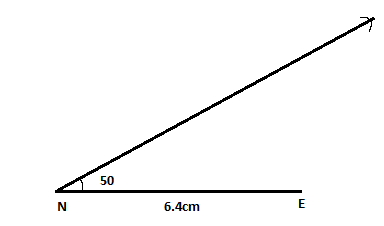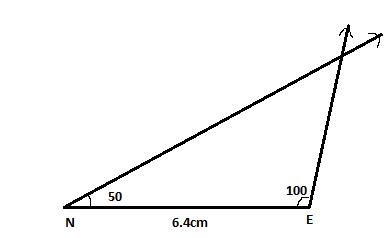
Construct ∆NET with measurement NE=6.4CM, \[\angle N = {50^ \circ }\]and \[\angle E = {100^ \circ }\].
Answer
574.8k+ views
Hint: First draw the base of triangle and then go for angles. With the help of a protector we can draw angles and finally construct ∆NET.
Complete step-by-step answer:
In the construction above we are given a base of triangle and two angles at base itself so lets start constructing step by step.
Step 1. Draw base of triangle.
For that take a ruler. Measure a length of 6.4cm and draw a line. And write the names of vertices.

Step 2. Draw any one angle with the help of a protractor .
For that take a protractor .Place it on each vertex and mark an angle of respective measure.

Step 3. Repeat the above step for another angle.

Now name the third vertex and erase the extra part of the construction.

This completes your construction of ∆NET.
Note: Students can make a habit of drawing a rough sketch of the construction. It will make their confusions clear. This will help them in getting an idea from where to start.
Note the angular measurements whether they are acute or obtuse.
Protractor has two angular scales . One is from the inner side and the other is from the outer side. One is clockwise and other is anticlockwise.
When you are drawing angles on your right hand side use the outer scale and when you are drawing angles on your left hand side use the inner scale.
In both cases start measuring from zero degrees.
In case of one side and two angles are given ,after drawing these three elements the point where your angular measurements intersects is your third vertex.
Complete step-by-step answer:
In the construction above we are given a base of triangle and two angles at base itself so lets start constructing step by step.
Step 1. Draw base of triangle.
For that take a ruler. Measure a length of 6.4cm and draw a line. And write the names of vertices.

Step 2. Draw any one angle with the help of a protractor .
For that take a protractor .Place it on each vertex and mark an angle of respective measure.

Step 3. Repeat the above step for another angle.

Now name the third vertex and erase the extra part of the construction.

This completes your construction of ∆NET.
Note: Students can make a habit of drawing a rough sketch of the construction. It will make their confusions clear. This will help them in getting an idea from where to start.
Note the angular measurements whether they are acute or obtuse.
Protractor has two angular scales . One is from the inner side and the other is from the outer side. One is clockwise and other is anticlockwise.
When you are drawing angles on your right hand side use the outer scale and when you are drawing angles on your left hand side use the inner scale.
In both cases start measuring from zero degrees.
In case of one side and two angles are given ,after drawing these three elements the point where your angular measurements intersects is your third vertex.
Recently Updated Pages
Master Class 8 Social Science: Engaging Questions & Answers for Success

Master Class 8 Maths: Engaging Questions & Answers for Success

Master Class 8 Science: Engaging Questions & Answers for Success

Class 8 Question and Answer - Your Ultimate Solutions Guide

Master Class 8 English: Engaging Questions & Answers for Success

Master Class 6 English: Engaging Questions & Answers for Success

Trending doubts
What is BLO What is the full form of BLO class 8 social science CBSE

Which one of the following groups comprises states class 8 social science CBSE

Citizens of India can vote at the age of A 18 years class 8 social science CBSE

Full form of STD, ISD and PCO

A couple went for a picnic They have 5 sons and each class 8 maths CBSE

Right to vote is a AFundamental Right BFundamental class 8 social science CBSE




